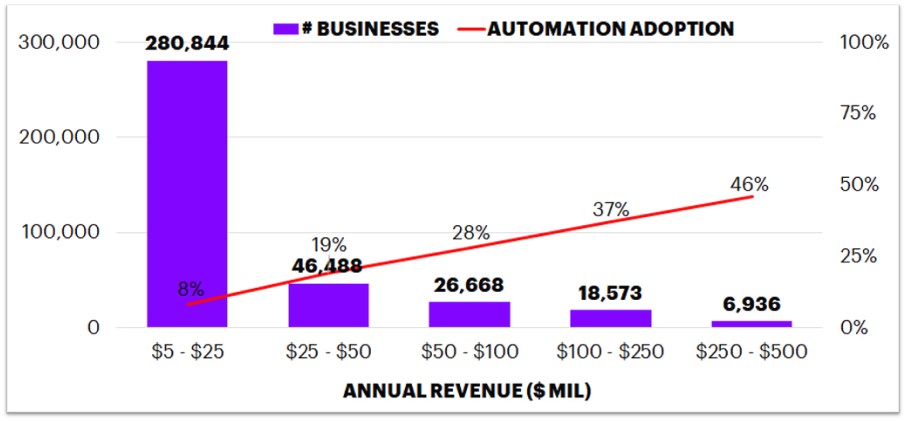Procurement and treasury roles within mid-market and large corporate organizations are becoming more strategic, and many corporate treasurers have identified payments as an avenue to streamline operations and improve efficiencies. Manual, paper-based processes remain highly prevalent for business-to-business (B2B) payments, with billions of dollars being spent on paper checks and manual invoices each year. Figure 1 demonstrates a significant lack of payments automation for US businesses, particularly among mid-market organizations.
Figure 1: US AP automation adoption

One opportunity mid-market organizations may explore to automate and improve their payment processes is the launch of a virtual card program. Virtual card programs provide organizations with the ability to assign unique credit card numbers to specific invoices for exact dollar amounts. With a virtual card program, invoices and payment files can be automatically coded and routed for approval before being sent to vendors, and real-time reporting is available for increased visibility into payment activity. These solutions also integrate into organizations’ ERP systems, which can reduce redundancies and manual efforts. Enhanced control, additional security and the ability to earn rebates are also benefits available for organizations with virtual card programs.
Virtual card providers are becoming more agile and technologically focused, making it easier for organizations to quickly and efficiently launch new programs. However, due to the complexity of B2B payments, a certain level of planning and resourcing is required for an effective launch. Figure 2 outlines key considerations and tactics for an end-user organization considering the launch of a virtual card program.
Figure 2: Staffing a virtual card program

The appropriate staffing level for a new virtual card program will vary depending on the size of the organization, but generally, a mid-market program can be staffed with a single dedicated resource to serve as owner of the program. This individual often serves as the program manager and is responsible for generating payments, managing supplier relationships, analyzing spend patterns and communicating with the card issuer. The program manager can work with the accounts payable, procurement and accounting departments regularly to identify new opportunities to move spend to virtual card to realize the vast benefits.
In today’s environment, virtual card programs can be implemented in just a few short weeks or even days in some cases. However, the steps taken prior to implementation are often critical in determining the success of the program. It is important for organizations to conduct their due diligence, establish executive support, identify check spend which may be moved to card, and understand the organizational requirements needed to launch a virtual card program prior to selecting a partner. With the right planning, a virtual card program can be an effective tool to drive significant savings and improve efficiencies for an organization.









In todays generation, where all people are using mobile phones, virtual card is very convenient to use in everyday’s transaction like paying bills, shopping, booking trips, hotels. You don’t need to bring anything but your mobile phone and your all set.
Yes, this blog is very informative. With the right planning, a virtual card program can be an effective tool to drive significant savings and improve efficiencies for an organization.